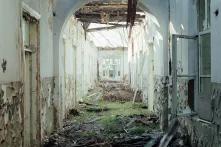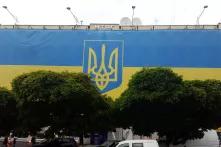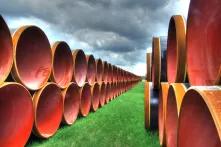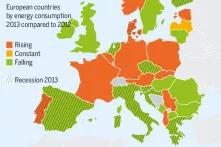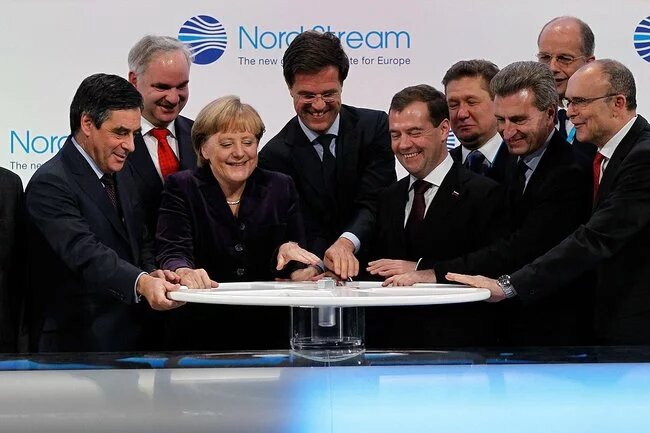
The gas pipeline Nord Stream II should double the existing natural gas transport capacity from Russia to Germany via the Baltic Sea. Juraj Mesík explains why the Kremlin will be the biggest winner of this project.
Nord Stream II, a project which aims to double existing natural gas transport capacity from Russia to Germany via the Baltic Sea from its current annual capacity of 55 billion cubic metres (bcm) to 110 bcm, is being presented to the German and EU public as a private business venture by six major companies: Germany’s Uniper and BASF/Wintershall, UK-Dutch company Royal Dutch Shell, Austria’s OMV and France’s ENGIE are each to hold a 10 percent stake, while Russia’s Gazprom is to hold a 50 percent stake.
While formally private, Gazprom has been demonstrated to be an arm of Kremlin policy and a key source of income for the Russian state. Gazprom’s gas deliveries have been repeatedly used for political blackmail, while the true limits of “private property” in Russia were fully exposed by the case of Mikhail Khodorkovsky and his erstwhile company, Yukos, that was forcibly broken up by the Russian government for clearly political purposes. The telling fate of former German Chancellor Gerhard Schröder – once the symbolic figure of a united Europe and today a Kremlin puppet – is a contagious example of a completely different personal story to that of Khodorkovsky. It demonstrates how working for Kremlin interests may be much better paid than working for the interests of the German and European people.
Interestingly, Robert Fico, prime minister of Slovakia and Schröder’s good friend, recently had at least two secretive meetings with Alexey Miller, Gazprom’s CEO and a member of Vladimir Putin’s inner circle. The first took place on 11 February, just three weeks ahead of Slovakia’s national election, while the second took place in late June 2016, one week before Slovakia assumed the EU presidency.[1] No statement about the purpose of these visits or the contents of the discussions was ever published.
Cui bono, Nord Stream II?
Let us return to Nord Stream II. Who benefits from this marriage between five super-rich Western European companies and the Kremlin?
At over 240 bcm, the existing capacity of gas pipelines between the EU and Russia already amounts to twice what is needed. The capacity of the Bratrstvo (Brotherhood) pipeline via Ukraine and Slovakia is 140 bcm, Nord Stream’s existing capacity is 55 bcm, the capacity of the Yamal pipeline via Belarus and Poland is 34 bcm, and several other smaller pipelines via Ukraine to Romania and the Balkans account for another c. 11 bcm. How does this 240 bcm transport capacity compare to the EU’s actual gas imports from Russia? According to Gazprom’s own data[2], Russia exported 100 bcm of natural gas to Western Europe in 2015 – far less than half of the existing transport capacity.
So what is the point in building another 55 bcm pipeline and augmenting an already deeply underutilised capacity? Indeed, only 43 percent of Nord Stream’s capacity was utilised in 2013, 65 percent in 2014 and 71 percent in 2015. Is European consumption of natural gas experiencing rapid growth? Not at all: from its 2010 peak of 502 bcm it had fallen 23 percent by 2014 to 387 bcm, the lowest level since 1995.[3] The EU’s gas consumption did increase to 402 bcm in 2015, but just ten years ago – in 2005 – it was 499.5 bcm.
Is the EU’s gas consumption expected to grow to justify the need for Nord Stream II? Hardly: the limited increase in 2015 consumption was the result of a significant drop in natural gas prices accompanying a dramatic fall in crude oil prices. In addition, a small contribution to the statistical increase in EU consumption can be attributed to the re-export to Ukraine of gas imported to Slovakia and Poland from Russia. The key fact is that 80 percent of all natural gas consumed in the EU is used by six Western European member states (Germany being the largest, followed by the UK, Italy, France, the Netherlands and Spain),[4] all of which have strong energy efficiency and renewable energy utilisation programmes. Unless Europe decides to waste cheap natural gas in vain, the decline in consumption will continue.
Doubled to 110 bcm, Nord Stream would be able to handle all of Russia’s gas exports to Western Europe. But what would the consequences of such a development be? Within a very short time, both the Brotherhood and Yamal pipelines would go out of business, and without continual maintenance and investment they would soon fall into disrepair. Stripped of important revenue sources, Poland, Slovakia, Belarus, Ukraine and their 100 million people would become economically weaker and more vulnerable to separate “deals” with Moscow.
The big winner would indeed be the Kremlin, securing more European money flowing to Moscow for a longer period of time. Western investment into Nord Stream II would commit Europe to Russian natural gas for longer, while intensified lobbying by the Western gas companies involved in the deal could discourage more aggressive energy conservation, encourage waste, and delay the transition to renewables.
Potential impacts of Nord Stream II
The aim of corporate and Russian propaganda is for the German public to believe that the “only” losers in a Nord Stream II deal would be Germany’s eastern neighbours. They would certainly be losers: an important Kremlin objective is, without a doubt, to increase pressure the EU’s eastern flank and on Ukraine in particular. An economically weaker eastern EU periphery and an economically and socially more polarised EU are exactly what the Kremlin is hoping for in its quest to destroy the European Union and re-establish the good old world order of the first half of the 20th century. Nord Stream II would make anti-EU propaganda and subversion much easier in an economically, socially and politically more polarised continent. A poorer Ukraine would be even more vulnerable to Russian occupation and military aggression, and Putin’s hold on Belarus would become even firmer.
Significantly, however, the deal would have negative consequences for Germany, France, Great Britain, the Netherlands and other European countries as well. Indeed, Nord Stream II would commit Germany and Europe to buying more Russian gas than necessary and for a longer period of time. The flow of money from the EU would thus continue to finance Russia’s extreme militarisation, which represents a direct and by far the most significant threat to peace in Europe. According to the Global Militarization Index[5], published annually by the Bonn International Center for Conversion, Russia is notoriously among the five most militarised countries in the world. Thirty-seven per cent of Russian federal budget expenditures between January and March 2016 – amounting to 1332 billion roubles – were spent on the military and security forces.[6] The vast majority of these funds came from oil and gas sales in Europe.
Gas revenues as Kremlin’s war chest
It is us – the Russian gas-consuming Europeans – who are helping finance Russia’s wars in Ukraine and Syria, its military occupations of Crimea, South Ossetia, Abkhazia and Transnistria, and provocative manoeuvres by Russian jets in the Baltic region and elsewhere. The more gas and oil we burn, the more money will go to Putin and his armies – those in uniform as well as armies of trolls – to wage hybrid wars against Europe.
Nord Stream II would commit Germany and Western Europe to continual and possibly increased natural gas consumption despite their declared goal to decarbonise the German and European economies. The year 2014 was the warmest on record, and the year 2015 was warmer still. Every month of 2016 thus far has broken previous world temperature records, and Japan Meteorological Agency data show that the first three months of 2016 were 1.5° C above the preindustrial level.
Does anyone still remember the Paris conference and calls to limit the temperature increase by 2100 to 1.5° C? We are already there in the first half of 2016! Does anyone in Europe really care, or is it all just lip service? Is burning more fossil fuels the real German and EU policy?
It is certainly the policy of Uniper, Shell, BASF, ENGIE and OMV. And, of course, of the Kremlin, which is existentially dependent on producing more and more CO2 and methane emissions by selling more and more natural gas and oil.
Are Germans serious about peace? Then they should stop financing Russian militarism – the only real external threat to Europe. They should import less, not more, gas from Russia!
Nord Stream II as a threat to both the EU and climate
Are Germans serious about the EU – Europe’s greatest political achievement in the wake of the bloody first half of the 20th century? Then they should stop financing its subversion and destruction through the Kremlin’s hybrid warfare.
Are Germans serious about climate change and the future of the planet? Then they should burn less, not more, fossil fuels – including burning much less natural gas.
Nord Stream stands against the EU’s survival, against peace in Europe, against the environment, against resource efficiency, against the climate. Is this enough to stop the deal between the Kremlin and five greedy companies, or will history once again justify those famous words attributed to Lenin, Putin’s predecessor in the Kremlin?
“These capitalists are such idiots – they will sell us the rope with which we will hang them.” Just replace “capitalists” with “member states of the EU”.
[1] http://energia.dennikn.sk/dolezite/zemny-plyn-a-ropa/fico-sa-opat-tajne…
[2] http://www.gazpromexport.ru/en/statistics/
[3] http://www.statista.com/statistics/265406/natural-gas-consumption-in-th…
[4] For details and ten-year consumption trends, see http://www.bp.com/content/dam/bp/pdf/energy-economics/statistical-revie…, p. 23.
[5] http://gmi.bicc.de/index.php?page=ranking-table
[6] http://www.kasparov.ru/material.php?id=570FB3D6A64AD
